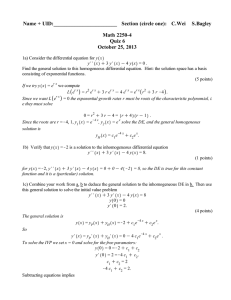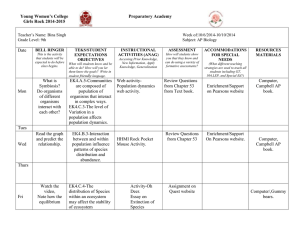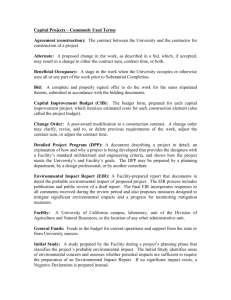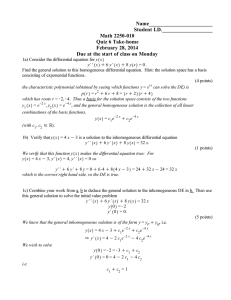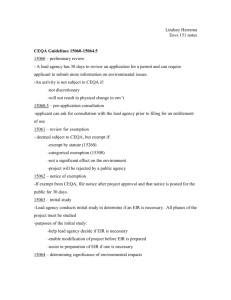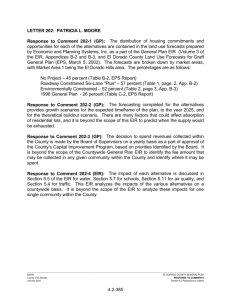ICO lo What is environmental information? (regulation 2(1))
advertisement
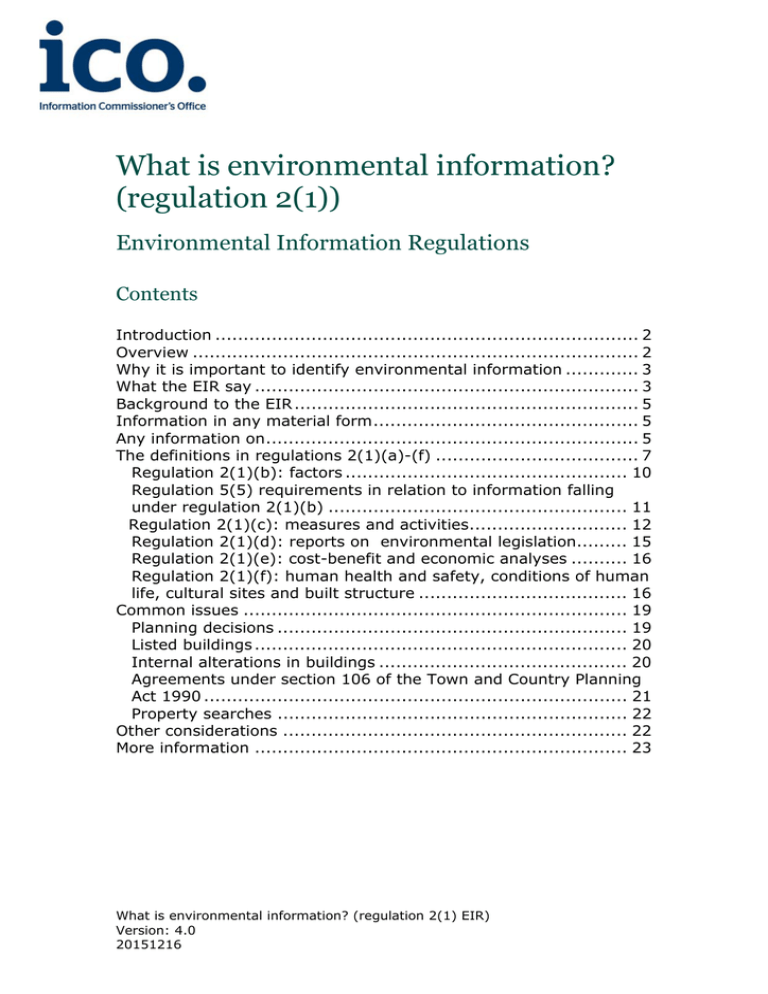
ICO lo What is environmental information? (regulation 2(1)) Environmental Information Regulations Contents Introduction ........................................................................... 2 Overview ............................................................................... 2 Why it is important to identify environmental information ............. 3 What the EIR say .................................................................... 3 Background to the EIR ............................................................. 5 Information in any material form ............................................... 5 Any information on .................................................................. 5 The definitions in regulations 2(1)(a)-(f) .................................... 7 Regulation 2(1)(b): factors .................................................. 10 Regulation 5(5) requirements in relation to information falling under regulation 2(1)(b) ..................................................... 11 Regulation 2(1)(c): measures and activities............................ 12 Regulation 2(1)(d): reports on environmental legislation......... 15 Regulation 2(1)(e): cost-benefit and economic analyses .......... 16 Regulation 2(1)(f): human health and safety, conditions of human life, cultural sites and built structure ..................................... 16 Common issues .................................................................... 19 Planning decisions .............................................................. 19 Listed buildings .................................................................. 20 Internal alterations in buildings ............................................ 20 Agreements under section 106 of the Town and Country Planning Act 1990 ........................................................................... 21 Property searches .............................................................. 22 Other considerations ............................................................. 22 More information .................................................................. 23 What is environmental information? (regulation 2(1) EIR) Version: 4.0 20151216 Introduction 1. The Freedom of Information Act (FOIA) and the Environmental Information Regulations 2004 (EIR) give rights of public access to information held by public authorities. 2. An overview of the main provisions of FOIA can be found in The Guide to freedom of information. 3. An overview of the main provisions of the EIR can be found in The Guide to the Environmental Information Regulations. 4. This is part of a series of guidance, which goes into more detail than the guides, to help public authorities fully understand their obligations and promote good practice. 5. This guidance explains to public authorities how to identify environmental information for the purposes of the EIR. Overview Public authorities that are subject to the EIR must consider disclosure of environmental information under the EIR, rather than under FOIA. Environmental information is any information on: o the state of the elements of the environment and the interaction among these elements; o factors affecting or likely to affect those elements; o measures or activities affecting or likely to affect those factors or elements, or designed to protect those elements; o reports on the implementation of environmental legislation; o cost–benefit and other economic analyses and assumptions used within the framework of those measures and activities; and o the state of human health and safety, conditions of human life, cultural sites and built structures in as What is environmental information? (regulation 2(1) EIR) Version: 4.0 20151216 2 much as they are or may be affected by those elements. Public authorities should interpret the phrase ‘any information on’ broadly. Why it is important to identify environmental information 6. Any public authority that is subject to the EIR must consider carefully the content of requested information in order to ensure that it handles a request under the correct regime: the EIR or FOIA. 7. This is particularly important when refusing to provide information, as the reasons why information can be withheld under FOIA (the exemptions) are different from the reasons why information can be withheld under the EIR (the exceptions). 8. There are also other differences. For example, under the EIR, information requests may be made verbally (unlike under FOIA), and there are differences in the time limits for compliance. 9. Public authorities should review the requested information before deciding whether it is environmental information or not. They should only make a decision about which legislation to apply based upon the wording of the request where this is unavoidable, eg where the information is not held. 10. If some of the information held is environmental information and some is not, then the public authority will have to apply the EIR to the environmental information and FOIA to the nonenvironmental information. Separate guidance on how this works when the public authority thinks the request may be costly, vexatious or manifestly unreasonable can be found in our guidance: Calculating costs where a request spans different access regimes and Manifestly unreasonable requests. What the EIR say 11. Regulation 2(1) states: What is environmental information? (regulation 2(1) EIR) Version: 4.0 20151216 3 2.—(1) In these Regulations— ……………….. “environmental information” has the same meaning as in Article 2(1) of the Directive, namely any information in written, visual, aural, electronic or any other material form on— (a) the state of the elements of the environment, such as air and atmosphere, water, soil, land, landscape and natural sites including wetlands, coastal and marine areas, biological diversity and its components, including genetically modified organisms, and the interaction among these elements; (b) factors, such as substances, energy, noise, radiation or waste, including radioactive waste, emissions, discharges and other releases into the environment, affecting or likely to affect the elements of the environment referred to in (a); (c) measures (including administrative measures), such as policies, legislation, plans, programmes, environmental agreements, and activities affecting or likely to affect the elements and factors referred to in (a) and (b) as well as measures or activities designed to protect those elements; (d) reports on the implementation of environmental legislation; (e) cost-benefit and other economic analyses and assumptions used within the framework of the measures and activities referred to in (c); and (f) the state of human health and safety, including the contamination of the food chain, where relevant, conditions of human life, cultural sites and built structures inasmuch as they are or may be affected by the state of the elements of the environment referred to in (a) or, through those elements, by any of the matters referred to in (b) and (c); What is environmental information? (regulation 2(1) EIR) Version: 4.0 20151216 4 Background to the EIR 12. The EIR derive from European law: an EU Directive and, originally, the Aarhus Convention. 13. The Aarhus Convention Implementation Guide1, published by the United National Economic Commission for Europe, explains the intentions behind the definition of environmental information in the Convention: “the clear intention of the drafters, however, was to craft a definition that would be as broad in scope as possible, a fact that should be taken into account in its interpretation”. Information in any material form 14. The definition of environmental information encompasses recorded information in any material form. Therefore it includes emails, drawings, sound recordings and CCTV recordings as well as hard copies of letters and other documents. As with FOIA, there is no requirement for public authorities to create information, but they are expected to extract existing information, for example from a database. For more details, please see our guidance: Information held by a public authority for the purposes of the EIR. Any information on 15. ‘Any information’ means environmental information covers any information about, concerning or relating to the various factors, elements and other items stated. 16. Public authorities should interpret ‘any information on’ broadly. Information that would inform the public about matters affecting the environment or enable them to participate in decision making, and help to achieve that purpose is likely to be environmental information, even if the information itself does not directly mention the environment. The test that public authorities should apply is whether the 1 http://www.unece.org/fileadmin/DAM/env/pp/Publications/Aarhus_Implementatio n_Guide_interactive_eng.pdf What is environmental information? (regulation 2(1) EIR) Version: 4.0 20151216 5 the information is on or about something falling within the definitions in regulations 2(1)(a)-(f), and not whether information directly mentions the environment or any environmental matter. Example In Ofcom v ICO and T-Mobile [EA/2007/0078, 4 September 2007] the First Tier Tribunal considered the application of ‘any information…on’. The applicant requested information about the location, ownership and technical attributes of mobile phone cellular base stations. Ofcom argued the names of mobile network operators were not environmental information as they did not constitute information “about either the state of the elements of the environment …. or the factors …. that may affect those elements.” The Tribunal disagreed and commented that “the name of a person or organisation responsible for an installation that emits electromagnetic waves falls comfortably within the meaning of the words “any information…on….radiation”. In our view it would create unacceptable artificiality to interpret those words as referring to the nature and effect of radiation, but not to its producer. Such an interpretation would also be inconsistent with the purpose of the Directive, as expressed in the first recital, to achieve “… a greater awareness of environmental matters, a free exchange of views [and] more effective participation by the public in environmental decision making…”. It is difficult to see how, in particular, the public might participate if information on those creating emissions does not fall within the environmental information regime”. On further appeal (to the High Court and the Court of Appeal) Ofcom did not challenge the Tribunal finding that the names were environmental information. 17. In line with the Tribunal’s comments above, it would not be acceptable to separate out (as non-environmental information) details such as names, which form an integral part of information falling under the EIR. Example In Mersey Tunnel Users Association (MTUA) v Information What is environmental information? (regulation 2(1) EIR) Version: 4.0 20151216 6 Commissioner and Halton Borough Council [EA/2009/0001, 24 June 2009] the MTUA had requested information about a proposal to introduce tolling on an existing bridge and a proposed bridge across the River Mersey. The Tribunal agreed with the Commissioner that the information fell within the definition of environmental information. The council had argued that the information on tolling was not sufficiently connected to the ‘measure’ (ie the proposal to construct a new bridge) to be environmental. However the Tribunal stated: “there is no dispute that the Mersey Gateway Project will have a significant impact on the state of elements of the environment, such as, at least, the land and the landscape, and on factors such as emissions, discharges and other releases into the environment, affecting or likely to affect the elements of the environment referred to, such that information relating to it would fall squarely within the definition of environmental information under Regulation 2(1) of the EIR” and “we are satisfied that tolling is an integral part to the Project and its viability.” The definitions in regulations 2(1)(a)-(f) 18. The EIR do not attempt to provide a definitive list of ‘environmental information’ but break down its scope into categories and within each category provide examples. Regulation 2(1)(a): elements of the environment 19. Any information on or about the state or condition of the elements of the environment is environmental information under regulation 2(1)(a). Example Information about the water quality of a river will be information on the state of water as an element of the environment. What is environmental information? (regulation 2(1) EIR) Version: 4.0 20151216 7 Example A map showing the location of mountain ranges, urban areas and woodland is information on the state of the land as an element of the environment. 20. Similarly information on or about the interaction between the elements of the environment is environmental information under this regulation. Example Information about coastal erosion from the sea is information on the interaction between two elements of the environment (water and land). 21. Regulation 2(1)(a) gives various examples of elements of the environment. The use of the words ‘such as’ in this subsection make clear that the list is not exhaustive, so public authorities need to be aware that information on the condition of other elements of the environment will also be environmental information. 22. Further guidance on what is covered by the examples of elements of the environment listed in regulation 2(1)(a) is given below. Air and atmosphere - The use of both words in this definition indicates that it encompasses air that is confined in some way, as well as the air outside. Since the air and atmosphere contain various gases and solid particles, the definition includes those. Water - Water may exist in various forms at different temperatures and in different conditions, and the definition covers all of them. The location of the water is immaterial underground, on the surface, or in natural settings. Soil and land - These include: o soil as the loose top layer on the earth’s surface where plants may grow; and What is environmental information? (regulation 2(1) EIR) Version: 4.0 20151216 8 o land as the solid parts of the earth, whether at the surface or underground. Note that the meaning of land for the purpose of the EIR is as an element of the environment, rather than the definition of land in English law. Landscape - This is landscape as it is commonly understood, ie an area of land whose character and appearance has resulted from the interaction of natural or human factors, or both. A landscape within this definition may be in any location and of any quality - urban or rural, attractive or ugly. Landscape can also be described as the visible features of an area of land, or the vista from a certain vantage point. Natural sites including wetlands, coastal and marine areas - This definition covers any sites that are regarded as examples of the landscape in its natural condition or as sites supporting natural flora or fauna. There is no need for such sites to have been formally designated, for example as a Site of Special Scientific Interest (SSSI). Biological diversity and its components, including genetically modified organisms - Biological diversity is the balance between the various species on the earth. A genetically modified organism (GMO) is a life form whose genetic material has been modified in a laboratory in a way that does not occur naturally. Examples of GMOs have been in crop farming and livestock production. Because this element of the environment is listed as ‘biological diversity and its components’ we consider that information about a single species won’t fall into the definition, but information on or about the balance between the species, and how individual species make up that balance, will. Examples Information on the life cycle of the badger is information on a single species and so won’t fall into the definition of information on the state of biological diversity and its components Information on how the population of earthworms and grubs is affected by the number of badgers in a particular location is information on the state of biological diversity and it components, as an element of What is environmental information? (regulation 2(1) EIR) Version: 4.0 20151216 9 the environment. Regulation 2(1)(b): factors 23. Information on factors affecting or likely to affect the elements of the environment is environmental information under regulation 2(1)(b). Example Information about the waste that is accidently leaked into a river is information on a factor (waste) which is affecting the state or condition of water (the river) as an element of the environment. 24. The word ‘factor’ here means something physical that has an impact or influence on the elements of the environment. 25. Information about a factor will only be environmental information under this regulation if the factor is ‘affecting’ or ‘likely to affect’ the state of the elements of the environment indicated in regulation 2(1)(a). 26. ‘Affecting’ means there has already been an impact on the state of the elements of the environment, or that the impact is current or ongoing. 27. ‘Likely to affect’ means there is a likelihood the factor will impact on the state of the elements of the environment. This does not have to be more probable than not, but it does have to be real and significant and substantially more than remote. 28. The effect could be either detrimental or beneficial, and large or small scale. 29. Again regulation 2(1)(b) provides a list of some factors and the words ‘such as’ indicate that these are examples rather than an exhaustive list. The factors listed as examples under this heading are as follows. Substances This includes all physical materials or matter, natural or synthetic, in solid, gas or liquid form. What is environmental information? (regulation 2(1) EIR) Version: 4.0 20151216 10 Energy In scientific terms this means the ability to do work and it includes all different types of energy: thermal, chemical, electrical, nuclear, kinetic, sound, potential, light and gravitational. So it covers familiar concepts such as heat, cooling, solar energy, sunlight, and nuclear and wind power. Noise Although noise is itself generated by sound energy, it is included here separately. A simple definition of noise is a sound, especially one that is loud, unpleasant, or disturbing. Radiation Radiation is energy transmitted as rays, waves, or in the form of sub-atomic particles. It can be natural or man-made. Waste Waste can be broadly interpreted to mean anything discarded. This would include household, industrial, agricultural and commercial waste. Radioactive waste Radioactive materials are widely used in many situations, settings and industries such as hospitals, industry, research, power generation, and the military. Radioactive waste is the unwanted or unusable by-product of these activities. Emissions, discharges and other releases These three terms may overlap. ‘Emissions’ and ‘discharges’ indicate the direct or indirect, accidental or deliberate release of substances, heat, radiation or noise into the air, water or land. ‘Release’ suggests liberation, or a change of state from confined to unconfined. For more details, please refer to our guidance: Information on emissions (regulation 12(9)) which considers the definition of ‘emissions’ in detail. Regulation 5(5) requirements in relation to information falling under regulation 2(1)(b) 30. When making available information falling within regulation 2(1)(b), public authorities must bear in mind the requirements of regulation 5(5). If the applicant requests this, the authority is required to do the following (so far as it is able to do so): either to inform the applicant where they can find available information on measurement procedures used What is environmental information? (regulation 2(1) EIR) Version: 4.0 20151216 11 in compiling the information, including methods of analysis, sampling and pre-treatment of samples; or to refer the applicant to a standardised procedure that was used. Regulation 2(1)(c): measures and activities 31. Information on measures and activities affecting or likely to affect the state of the elements of the environment, or factors such as those listed in regulation 2(1)(b), is environmental information by virtue of regulation 2(1)(c). Example Information on a proposal to build a new retail park is information on a measure (the building proposal) likely to affect the state of the land as an element of the environment. 32. ‘Affecting’ means the effect on the elements of the environment, or factors such as those listed in regulation 2(1)(b), has already occurred, or is current or ongoing. 33. ‘Likely to affect’ means there is a likelihood the elements of the environment, or factors such as those listed in regulation 2(1)(b), would be affected if the measure went ahead. This likelihood does not have to be more probable than not, but does have to be real and significant and substantially more than remote. 34. The effect could be either detrimental or beneficial, and large or small scale. 35. Therefore when the measure under consideration is something that is proposed for the future, public authorities should consider whether, if the measure were to go ahead, it would be likely to affect the elements and factors referred to in regulations 2(1)(a) and (b). The likelihood of a plan actually coming to fruition is not a relevant consideration. Once it is established that there is an intention to initiate a plan or to develop a policy, then this is sufficient to bring information which will contribute to the preparation of that plan within regulation 2(1)(c). What is environmental information? (regulation 2(1) EIR) Version: 4.0 20151216 12 36. This position derives from the Aarhus Convention and the Directive, which together seek to involve the public during the preparation of plans and programmes relating to the environment, acknowledging the connection between access to environmental information and effective participation in environmental decision-making. Therefore it would not be correct to only consider information to be environmental at the point at which a plan is likely to go ahead. This would effectively exclude information relevant to participation at the preparation stage of plans relating to the environment. 37. Information on measures and activities designed to protect elements of the environment is also environmental information under regulation 2(1)(c). Example Information on regulations to determine fishing quotas will be information on a measure (the fishing quota regulations) designed to protect biological diversity and its components (the balance between the species of fish in the sea in specified areas) which is an element of the environment under regulation 2(1)(a). 38. Again the regulation gives ‘such as’ examples of measures or administrative measures: policies, legislation, plans, programmes and environmental agreements. This covers a broad range, and will include steps taken to ensure something happens and the methods, processes or instruments used to implement the measure. Example ICO Decision Notice FER0148337, upheld by the First Tier Tribunal in Rudd v Information Commissioner and The Verderers of the New Forest [EA/2008/0020, 29 September 2008] Information about payments received by individual verderers under the Countryside Stewardship Scheme and legal advice obtained by the Verderers of the New Forest on the Countryside Stewardship Scheme were environmental information, as information on a measure that affects or is likely to affect an element of the environment. What is environmental information? (regulation 2(1) EIR) Version: 4.0 20151216 13 39. Also included will be regulatory measures such as Acts of Parliament and local by-laws, taxes, prosecutions, charges and voluntary agreements. ‘Policies’ are not restricted to environmental policies, but will cover those on development, economic, transport or health if they are likely to affect the elements of the environment. 40. Public authorities should remember the earlier part of regulation 2(1) states environmental information is ‘any information…on’ the matters listed later in regulation 2(1). This means regulation 2(1)(c) covers: documents setting out the measures themselves; any information on the way they have been developed and are applied; and any information about the results of that application. 41. It can sometimes be difficult to decide which parts of large projects fall within this definition. It is often clear that the main project itself constitutes a measure that will affect the environment: eg building a bridge. Questions often arise when sub-projects or connected projects are considered as separate projects or measures, eg IT projects. Is the information on these projects information on the overall measure and therefore environmental information? The key test in this situation is how integral the additional project or measure is to the overall measure; eg if an IT system was integral to an automatic floodgate system, then this would still be information about the measure of the floodgate system. This is the approach taken by the Tribunal in the Mersey Tunnel Users Association case referenced above. Example: In Omagh District Council v Information Commissioner [EA/2010/0163, 20 May 2011] the First Tier Tribunal considered a request for the names of the authors of an Equality Impact Assessment (EQIA) about a policy on the disposal of land containing a memorial to IRA members who had died in hunger strikes in 1981. The memorial comprised a flag, a monument and ten trees. The council had refused the request under FOIA; the Commissioner instead found that the 14 What is environmental information? (regulation 2(1) EIR) Version: 4.0 20151216 information requested was environmental and should have been handled under the EIR. This was on the basis that the information was directly related to a measure – the proposed sale of the land - that would impact on the state of the land. The council argued that the focus of the information was on equal opportunities, and that the EQIA was too remote from a measure affecting the environment, since it was too far removed from the final decision on the sale of the land. The Tribunal did not accept these arguments and decided the information did have a significant connection with the decisions on the sale of the land and the future of the memorial and therefore was environmental information. The Tribunal supported the ICO approach and upheld the Decision Notice. Regulation 2(1)(d): reports on environmental legislation 42. Reports on the implementation of environmental legislation are environmental information under regulation 2(1)(d). There is likely to be some overlap between information under this definition and that in regulation 2(1)(c), so 2(1)(d) may be viewed as clarifying and expanding on 2(1)(c). Examples of reports would include any reports reviewing or monitoring the operation or performance of environmental legislation, or evaluating its success or failure. 43. The European Commission has previously explained2 ‘environmental legislation’ as “legislation which, irrespective of its legal basis, contributes to the pursuit of the objectives of … policy on the environment …: preserving, protecting and improving the quality of the environment, protecting human health, the prudent and rational utilisation of natural resources, and promoting measures at international level to deal with regional or worldwide environmental problems…”. 2 http://eur-lex.europa.eu/legal-content/EN/TXT/?uri=CELEX:32006R1367: Regulation (EC) No 1367/2006 on the application of the provisions of the Aarhus Convention on Access to Information, Public Participation in Decision-making and Access to Justice in Environmental Matters to Community institutions and bodies What is environmental information? (regulation 2(1) EIR) Version: 4.0 20151216 15 Regulation 2(1)(e): cost-benefit and economic analyses 44. Information on cost-benefit and other economic analyses and assumptions used within the framework of the measures and activities referred to in regulation 2(1)(c) will be environmental information under regulation 2(1)(e). 45. The fact that economic and financial information were included in the definition in the Aarhus Convention stemmed from the recognition that, when making decisions, it is important to take into account both environmental and economic considerations. 46. The reference in 2(1)(e) links back to the ‘measures’ and ‘activities’ in (c), which means that the economic and financial analyses and assumptions stated here in (e) are those taken into account when considering and implementing the 2(1)(c) measures and activities. Regulation 2(1)(e) therefore ensures the definition of environmental information extends to information about the economic and financial implications of environmental measures and activities. Regulation 2(1)(f): human health and safety, conditions of human life, cultural sites and built structure 47. This definition is more specific than the other definitions in regulation 2(1) and does not take the form of an illustrative list of examples. It relates to the following areas: the state of human health and safety (this will include the contamination of the food chain, where relevant to the state of human health and safety); conditions of human life; and cultural sites and built structures. These areas will be environmental information to the extent that they are or may be affected: o by the state of the elements of the environment in 2(1)(a) or, through those elements, o by any of the factors, measures or activities referred to in 2(1)(b) and (c). What is environmental information? (regulation 2(1) EIR) Version: 4.0 20151216 16 Examples o A public authority holds a report on the cause of an outbreak of sickness among a local population. The report concludes that the sickness arose because industrial waste had been illegally emptied into a river and this contaminated fish which were later sold for human consumption. This report would be environmental information under regulation 2(1)(f). This is because it is information on a contamination of the human food chain by an activity under regulation 2(1)(c) (the emptying of industrial waste into a river) that has affected human health and safety, through the state of an element of the environment in regulation 2(1)(a) (the contaminated water). o The public authority also holds a separate report on a different outbreak of sickness in another area. This report concludes that the sickness arose because a restaurant failed to properly cook the meat it served. In this case the report is not environmental information. This is because the information does not link the contamination of the food chain and the resultant effect on the state of human health and safety back to the state of an element of the environment, or a measure affecting the state of the elements of the environment. Examples o Information on how a building has been affected by subsidence of the land it stands on is environmental information. This is because it is information on the state of a built structure inasmuch as it is affected by the state of the land, as an element of the environment. o Information on how a built structure has been affected by use of poor building materials is not environmental information under regulation 2(1)(f). This is because there is no information on how the building has been affected by the state of any element of the environment. What is environmental information? (regulation 2(1) EIR) Version: 4.0 20151216 17 48. This definition uses different terms from the other definitions in regulation 2(1): ‘inasmuch as they are affected by’ and ‘inasmuch as they may be affected by’. 49. ‘Are affected by’ again means that the effect has already occurred or is current or ongoing. 50. ‘May be affected by’ means that there has to be some possibility of an effect. This is a lower test than the ‘likely to affect’ test under regulations 2(1)(b) and (c). 51. The effect could be either detrimental or beneficial, and large or small scale. Again the regulation provides a list but this time it is a definitive rather than a ‘such as’ list, covering the following items only: the state of human health and safety; conditions of human life; cultural sites; and built structures. The contamination of the food chain is an example of human health and safety rather than a category in its own right. 52. Further guidance on the list at regulation 2(1)(f) is provided below. Human health and safety - this refers to a collective state of human health and safety. It will include such matters as diseases, medical conditions and risks to human safety. The definition specifically mentions the contamination of the food chain, which follows concerns over environmental factors affecting our food. Conditions of human life - will cover, for example, information on housing, poverty, employment, social welfare, heating, access to clean water, sanitation, and healthcare. Cultural sites - will include places that have a historical, literary, educational, or artistic value, and religious, ethnic, or social significance. It will cover modern as well as historical, and urban as well as rural locations. What is environmental information? (regulation 2(1) EIR) Version: 4.0 20151216 18 Built structures - will include buildings and built structures, as well as built infrastructure, such as roads, railway lines, pylons, aerials, bridges, canals and tunnels. Common issues 53. This section contains more examples of specific, detailed issues in the EIR. Planning decisions 54. Information relating to planning matters and planning decisions will often be environmental information. For example, in the case of a planning decision, this might be on the basis that the particular planning regulation under which the decision has been made is a measure affecting or likely to affect the factors and elements in 2(1)(a) and (b), or designed to protect those elements. If it is, then the decision and the related planning application become environmental information because they are information on the implementation of the particular planning regulation in question. 55. This does not mean that all information contained within planning files will inevitably be environmental information. It will be necessary to identify what measure the information is on (ie the particular planning regulation being applied) and ensure that this is a measure affecting or likely to affect the factors and elements in 2(1)(a) and (b), or designed to protect those elements. 56. An alternative approach would be to consider if the planning application is a measure (a plan) likely to affect the elements of the environment. Example In London Borough of Southwark v Information Commissioner, Lend Lease (Elephant and Castle) Limited and Glasspool (EA/2013/0162) 9 May 2014 the First Tier Tribunal considered a request for a financial viability assessment submitted with a planning application by Lend Lease to redevelop a very large area, including much of the Heygate Estate. The Tribunal commented that although “there may be a tendency to overuse EIR; almost an assumption that, for What is environmental information? (regulation 2(1) EIR) Version: 4.0 20151216 19 example, anything to do with land or anything to do with the planning process in England and Wales is outside the scope of FOIA” the answer lay in “a purposive application to the facts of a case of the definition of “environmental information” in Reg 2(1) EIR”. For example, it considered that appropriate weight should be given to “the state of the elements of the environment”. On that basis, the Tribunal decided that the project was so large that it was likely to affect the state of the landscape as an element of the environment, and was therefore a measure which fell within regulation 2(1)(c). In addition the viability assessment was an economic analysis used within the framework of that measure and activity, and fell within regulation 2(1)(e). Therefore the requested information was environmental information. Listed buildings 57. The Commissioner’s view is that information relating to a decision whether or not to list a building is environmental information. This is because the listing process is an administrative measure which is likely to affect the environment, under the definition in regulation 2(1)(c). 58. Such information would continue to be environmental information regardless of whether the process leads to a decision to list the building, or not. 59. Information on applications for listed building planning consent and decisions on such applications may fall under either the EIR or FOIA, depending on the nature of the application. Internal alterations in buildings 60. Example In Black v Information Commissioner (EA/2011/0064, 8 September 2011) the First Tier Tribunal considered a request for information about policies concerning the fitting of reproduction or antique fireplaces in a grade one listed Regency building in central London. The Information What is environmental information? (regulation 2(1) EIR) Version: 4.0 20151216 20 Commissioner’s decision notice had drawn a distinction between internal and external works and concluded that information concerning internal fixtures, such as fireplaces or chimney pieces, did not fall within the definition of ‘environmental information’ in Regulation 2(1) of EIR. This meant that aspects of the information request fell to be considered under FOIA rather than EIR, and that certain provisions of the EIR did not apply to that aspect of the appellant’s original information request. The Tribunal upheld the decision notice, stating that “on a plain reading of both the Directive and the EIR (which are identical in any event) the Tribunal finds that information relating to the internal fixtures of a building does not constitute ‘environmental information’ within the definition, whether as landscape or otherwise”. Agreements under section 106 of the Town and Country Planning Act 1990 61. Agreements under section 106 of the Town and Country Planning Act 1990 can be regarded as ‘environmental agreements’ as listed in regulation 2(1)(c). If the agreement affects or is likely to affect any of the elements referred to in regulation 2(1)(a) and factors referred to in regulation 2(1)(b), or is designed to protect those elements, the information within the agreement is environmental and subject to the EIR. Example In Kirkaldie v Information Commissioner and Thanet District Council [EA/2006/0001] 4 July 2006, the First Tier Tribunal considered a request for legal advice on an agreement made under section 106 of the Town and Country Planning Act 1990 between a local planning authority and a developer in relation to Manston Airport. Such agreements commonly set out planning obligations by the developer in relation to a planning proposal. As part of its decision, the Tribunal found that the request should have been handled under the EIR rather than under FOIA because: such an agreement amounted to environmental information under regulation 2(1)(c) as a measure affecting or likely to affect the elements in 2(1)(a) and 21 What is environmental information? (regulation 2(1) EIR) Version: 4.0 20151216 (b); and the legal advice was ‘on’ the agreement: “The Legal Advice……related to the enforceability of the s106 Agreement, land usage and other planning matters”. The Tribunal also said that “entering into and extending such an agreement is the sort of measure envisaged by the rule which is “likely to affect the elements and factors referred to in (a) and (b) as well as measures or activities designed to protect these elements.” However in the view of the Information Commissioner it is not necessary to say that entering into and extending such an agreement is also a measure. Once it is established that the s106 Agreement is a ‘measure affecting or likely to affect the elements and factors referred to in (a) and (b)’ then the legal advice is environmental information because it is information on this measure. Property searches 62. The majority of the information that is used to answer questions in a property search form is likely to be environmental information. This is because it affects or is likely to affect the use and therefore the state of the land (regulation 2(1)(c)). For more details, please see our guidance Property searches and the EIR. Other considerations 63. For further information about which public authorities are subject to the EIR, and request handling under the two different pieces of legislation, see The Guide to freedom of information and The Guide to the Environmental Information Regulations. 64. If the information is not environmental information, the EIR are not relevant and public authorities will instead need to consider the request under FOIA. Please refer to the Guide to freedom of information. What is environmental information? (regulation 2(1) EIR) Version: 4.0 20151216 22 More information 65. Additional guidance is available on our guidance pages if you need further information on the EIR or FOIA. 66. This guidance has been developed drawing on ICO experience. Because of this, it may provide more detail on issues that are often referred to the Information Commissioner than on those we rarely see. The guidance will be reviewed and considered from time to time in line with new decisions of the Information Commissioner, tribunals and courts. 67. It is a guide to our general recommended approach, although individual cases will always be decided on the basis of their particular circumstances. 68. If you need any more information about this or any other aspect of freedom of information, please contact us, or visit our website at www.ico.org.uk. What is environmental information? (regulation 2(1) EIR) Version: 4.0 20151216 23
